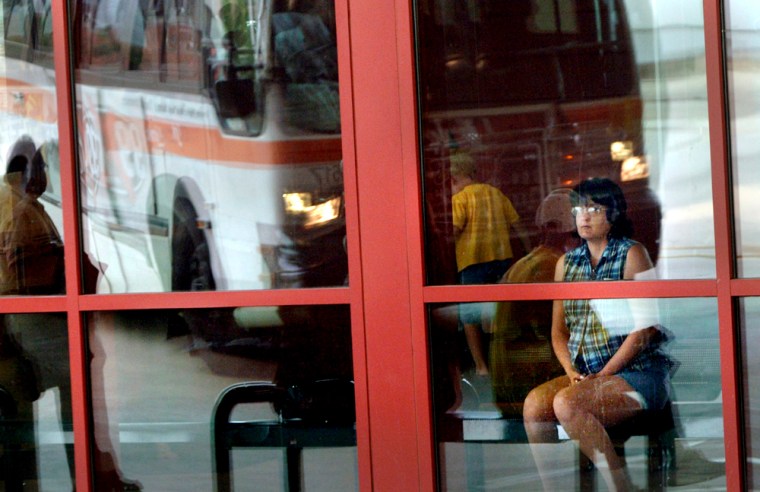Hobbled by artificial knees, Tom Mahoney doesn’t drive but says he still feels the pinch of high gasoline prices nearly every day on buses that offer dollar-a-trip rides around this central Illinois city.
“Before they were very seldom full, now sometimes you have to stand. You never used to see that,” said Mahoney, 52, of Peoria.
Ridership surged 15 percent in April compared with the same period a year ago on Peoria’s Citylink buses, among many across Illinois and the nation hauling bigger loads as pump prices hover near $3 a gallon with no relief in sight.
Fuel costs are just one factor driving up boardings, according to transportation officials. They say expanded hours and routes, fleet upgrades and jobs created by improving local economies also have helped fill once-empty seats.
Still, they say it’s likely no coincidence that ridership jumped last fall after Gulf Coast hurricanes tightened gasoline supplies and again as prices soared about 60 cents a gallon since March and stayed there.
“It’s one of those things that’s hard to tell unless you go out and survey people. But if I were a guessing woman, I would certainly guess that,” said Jennifer Garrity, spokeswoman for Rock Island, Ill.-based MetroLINK. The system’s weekday ridership through eight Illinois cities near the Iowa border was up 15 percent in April compared with a year ago.
Peter Weber, general manager of the Bloomington-Normal Public Transit System, agrees.
“Trying to sort out exactly how much is attributed to this versus that is hard to say. But I think common sense tells most people that gas prices have had an impact,” said Weber, whose buses have seen 9 percent more riders through April.
Nationally, bus ridership rose less than half a percent last year, though some transit systems posted bigger gains, including a 14.5 percent increase in Minneapolis, 7.5 percent in Dallas and 7.4 percent on the Pace system in suburban Chicago.
But transportation officials note that ridership jumped 2.5 percent in the third quarter of 2005, when gasoline prices spiked briefly in the wake of hurricanes Katrina and Rita, and they expect a similar rise in response to this spring’s higher fuel prices, which are expected to linger at least through summer.
“High gas prices are causing people to take a second look at buses and other public transportation. They may have decided against it when it cost $20 to fill the tank, but now that it’s $40 or $45 or more, they’re looking at what their options are,” said William Millar, president of the Washington-based American Public Transportation Association.
High fuel prices also have a downside for bus systems, which are dealing with hefty cost overruns for their largely diesel-power fleets. Many say extra money in fare boxes is offsetting the added expense, but Springfield is considering a Sept. 1 fare increase from 75 cents to $1 to counter fuel costs running about 45 percent ahead of last year.
“It’s bad timing. It could steer some new riders back to their cars. ... We’re assuming a minimal loss of ridership, about 2 percent,” said Richard Fix, managing director of the Springfield Mass Transit District.
Transportation officials say convenience — not cost — is their biggest challenge in luring riders, especially in smaller cities where commute times are short and parking is inexpensive and plentiful.
“Folks just want to be able to jump in their car and come and go the second they want to,” said Linda Podeschi, executive director of the Illinois Public Transportation Association.
Because of that, transportation officials say high gasoline prices are likely steering lower-income riders to bus stops but haven’t yet swayed most middle- and upper-income drivers who can afford pricey fill-ups.
Jeremy Hopwood says prices would have to hit $4 a gallon before he would consider parking his Jeep and taking a bus to his job at a downtown Peoria bank.
“If you can afford it, you’re going to do it. ... You’re paying for convenience,” said Hopwood, 31, of Peoria.
Bill Cartwright, general manager of the Metropolitan Tulsa Transit Authority, says high-tech and other well-paid workers are already riding his buses in the middle of Oklahoma’s oil country. Ridership is up 28 percent on regular routes through May, while a park-and-ride service for commuters has surged 50 percent, Cartwright said.
“What you really need to do is get people to take that first ride,” Cartwright said. “Most people think the public transit in their city isn’t as good as it is.”
Millar, whose Washington-based association’s 1,600 members include about 400 transit systems, agrees and predicts many of those new riders will stick even if gasoline prices retreat.
“Certainly none of us likes to wait,” Millar said. “But good things are worth waiting for, and public transportation is one of those if we want to save money, ease congestion and have cleaner air and less addiction to foreign oil.”
